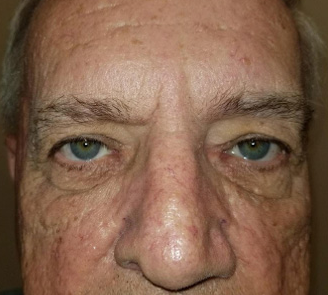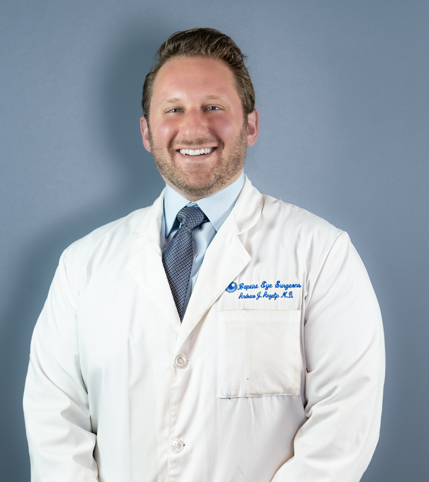RECONSTRUCTIVE EYE SURGERY
Why is Reconstructive Eye Surgery Needed?
When there are problems with the eyelids, tear ducts, and the eye socket, or orbit, reconstructive surgery may be necessary to restore proper function and vision. Dr. Anzeljc, our specialized oculoplastic surgeon, is extensively trained in surgical procedures to address anything around, but not within, the eye in these cases.
Oculoplastic surgeries correct issues outside the eye, which might involve functional problems with the upper or lower eyelids, blocked or excessive tearing, tumors, lacerations, or damaged eye sockets, or orbits. The reconstructive procedures Dr. Anzeljc performs are targeted to helping people have fully functional eyes, resulting in improved vision and quality care.
Reconstructive Procedures
Upper and Lower Eyelid Surgery for Improved Vision
One of the most common reconstructive surgeries is for droopy or heavy upper eyelids. It’s common for heavy upper eyelids to affect vision to some degree. Sagging skin or excess fat on the upper eyelids can reduce peripheral vision, and excess skin that covers the eyelashes can also impair vision. If vision is affected, insurance typically covers the surgical procedure to “lift,” or correct, the heavy eyelid. Because more light is able to come into the eye and peripheral vision is usually improved, patients are often surprised by how much better they can see after surgery.
Lower eyelids can sometimes turn outward or inward, which can be extremely irritating to the eye and lead to a variety of symptoms including pain and infection. If a lower eyelid is turned outward away from the eye it can also lead to either drying out or excessive tearing pouring down the cheeks. If the lower eyelid is turned in, the eyelashes tend to rub on the eyeball, leading to severe irritation and risk of infection. There are precise surgical procedures to correct lower eyelid disorders in these instances.


An example of a successful Bilateral Upper Ptosis Procedure
Correction of Eyelid Defects
Defects of the upper or lower eyelids may result from a congenital disorder, an injury or trauma, or the removal of a tumor. The eyelids are intricately designed to protect our eyes, so it’s imperative that they are healthy for our eyes to function properly. If there’s a defect, Dr. Anzeljc will address both functional and cosmetic needs in order to restore proper operation of the eyelid and to improve the patient’s appearance.
Inflammatory Problems of Eyelids
Inflammation of the eyelids is called blepharitis, and it typically affects both eyelids and involves the part of the eyelid where the eyelashes grow. Several diseases and conditions can cause blepharitis, but it most commonly occurs when the oil glands near the base of the eyelashes become clogged. The inflammation can cause moderate to severe symptoms, including red, irritated eyes, scarring of the eyelids, excessive tearing, injury to the cornea, or the edges of the eyelid may turn inward or outward. Eyelid inflammation is often a chronic condition and surgery may be necessary if symptoms are severe or eyesight is compromised.
Botox for Facial Spasm
Abnormal blinking on both sides is referred to as blepharospasm. Botox injections have been proven effective for relaxing the eyelid muscles and relieving the involuntary spasms. There are also potential surgical options to relieve the spasms.
When patients have an involuntary twitch on one side of their face, this may be due to a temporary muscle spasm called myokymia, or persistent twitching may be due to hemifacial spasm, which is a neuromuscular disorder affecting facial muscles that are activated by facial nerves. The spasms often begin with sporadic tics of the eye muscle, which can become severe enough to force the eye shut. The spasms may then spread to the facial muscles, which may result in the mouth being pulled to one side. In extreme cases, the spasms eventually spread to all of the muscles on one side of the face and neck. Injecting Botox into the affected muscles has proven to be a successful non-surgical treatment option for many patients with varying degrees of facial spasms.
Functional Orbital Issues
The orbit is the bony cavity that houses the eyeball, muscles, nerves, blood vessels, and the surrounding fat. Any of these structures may degenerate into an orbital tumor, which can cause a variety of symptoms ranging from a bulging eye to double vision or vision loss. The orbit, or eye socket, can also be damaged due to trauma or an injury. The goal of any orbital surgery is to restore full function to the eye as well as to preserve or improve a patient’s appearance.
Tear Duct Disorders
A partial or complete obstruction in the tear drainage system may be due to an injury, an infection, a tumor, or a previous sinus, nasal, or eyelid surgery. A blocked tear duct impairs the eye’s tear drainage system, causing a watery, irritated or chronically infected eye. Tearing is considered excessive when tears are running down a patient’s cheek, not just pooling in the eye. Surgical procedures have been shown to be successful in resolving most all tear duct disorders, regardless of the initial cause.
Request an Appointment With Dr. Anzeljc
Dr. Andrew Anzeljc specializes in oculoplastic surgery, including eyelid surgery and other functional procedures. [See Dr. Anzeljc discussing oculoplastic surgery]
If you have concerns about your upper or lower eyelids, have excessive tearing or blocked tear ducts, have facial spasms, or have an injury around or near the eye, schedule a consultation with Dr. Anzeljc to discuss which might be right for you. To request an appointment or get directions to our Knoxville and Morristown locations, visit our website. Call us at 865-579-3920 for more information.



